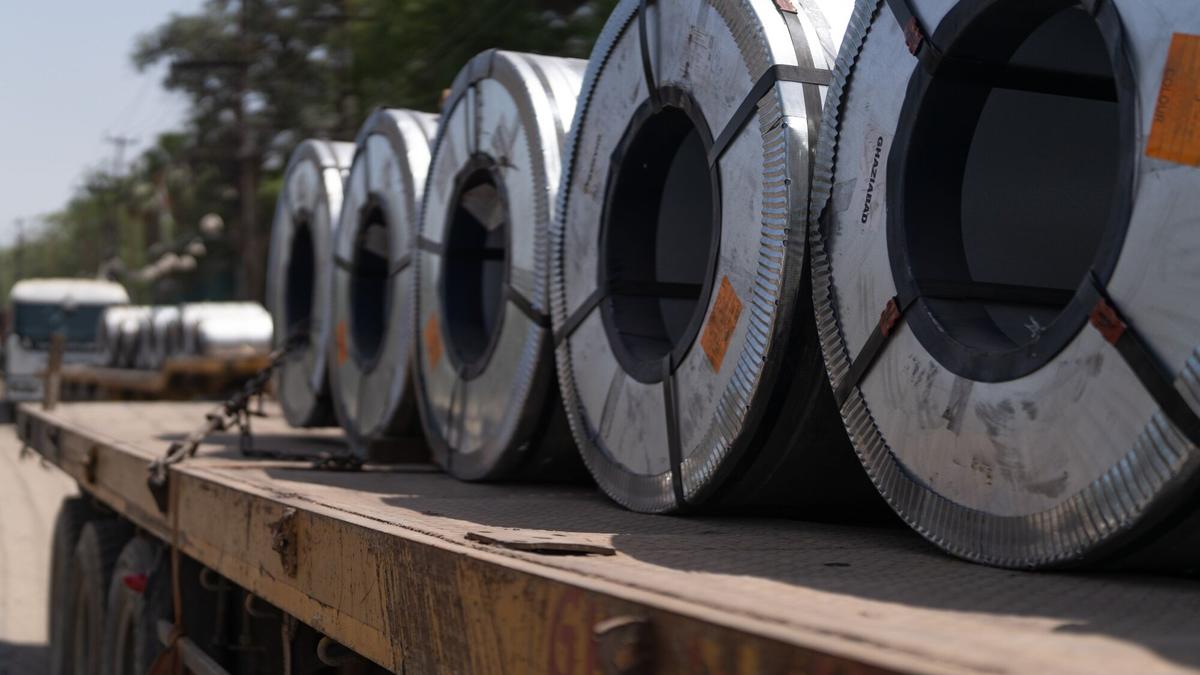
Ministry of Steel’s internal data, accessed by businessline, show imports witnessing a sequential decline since January.
| Photo Credit:
Bloomberg
A month after imposition of safeguard duty on steel imports, shipments coming into the country saw a 40 per cent year-on-year (y-o-y) decline in May to 0.43 million tonnes (mt), as against the 0.7 mt in the year-ago-period. On a sequential basis, imports declined by nearly 20 per cent as compared to 0.52 mt in April, indicating reduced buying from China.
Finished steel include alloy, non-alloyed and stainless steel.
In May, as per Ministry sources, 0.3 mt of non-alloyed metal were imported, down 15 per cent sequentially and 40 per cent y-o-y; while alloy and stainless steel imports were at 0.13 mt, down 24 per cent sequentially and 44 per cent y-o-y.
“Post January, talks around imposition of safeguard duty picked up pace. Post imposition, imports from some countries are down, as the numbers show,” a Steel Ministry official said.
According to market intelligence firm BigMint (formerly SteelMint), in May, South Korea and China are still amongst the top two importers. While shipments from South Korea saw a 24-25 per cent increase y-o-y as per provisional data, Chinese shipments dropped by 27-30 per cent. The Steel Ministry is yet to come up with detailed numbers for the month.
Sequential decline
Ministry of Steel’s internal data, accessed by businessline, show imports witnessing a sequential decline since January.
Import peaked in the first month of this calendar year to 0.95 mt and has since then been on a decline as talks of safeguard duty gained traction. In February, alloy imports had come down to 0.6 mt, and came down further to 0.56 mt in March.
On April 21, India imposed a 12 per cent provisional safeguard duty on metal shipments coming in specially from China and Vietnam, in a bid to ensure better pricing power for mills in domestic markets. The duty imposition is for a 200-day period. A safeguard duty is a trade restriction measure – a sort of tax.
“The domestic still industry in India is concerned about the growing reliance on imports, especially from countries like South Korea and Japan, that benefit from preferential tariffs under FTA,” the BigMint report stated.
Mixed trends
Concern around exports remain. Sequentially, exports are up in May at around 0.4 mt versus 0.38 mt in April. However, exports remained depressed by 10 per cent on a y-o-y basis.
India was a net importer of steel for May, by 0.03 mt.
Export offers from Indian steelmakers continue to be on the slower side, especially in markets in West Asia and Vietnam. This apart, there continues to weaker demand (and slower buying) in key EU markets.
China is dominating most of the overseas markets. Data available with trade sources show, the Chinese upped exports by 10 per cent y-o-y and up 1-2 per cent to nearly 11 MT.
And Indian mills are not keen to compete on pricing.
Price and production trends
Steelmakers are currently focusing on the domestic market, which continues to have stable demand.
Consumption increased by 7 per cent y-o-y to 25.1 mt (April and May), while production of finished steel was up 7.4 per cent during this period.
However, despite the demand, steel-makers have rolled over prices in June on bearish sentiments and upcoming monsoons.
Prices were in the ₹52,000-54,000 per tonne range for benchmark hot rolled coils; while for cold rolled coils it was around ₹60,000 per tonne.
Published on June 10, 2025
Anurag Dhole is a seasoned journalist and content writer with a passion for delivering timely, accurate, and engaging stories. With over 8 years of experience in digital media, she covers a wide range of topics—from breaking news and politics to business insights and cultural trends. Jane's writing style blends clarity with depth, aiming to inform and inspire readers in a fast-paced media landscape. When she’s not chasing stories, she’s likely reading investigative features or exploring local cafés for her next writing spot.






